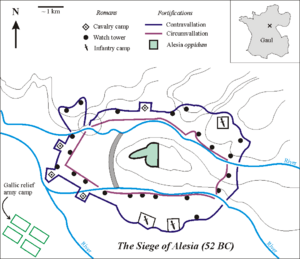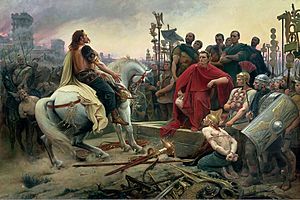52 BC facts for kids
| Millennium: | 1st millennium BC |
|---|---|
| Centuries: | 2nd century BC – 1st century BC – 1st century |
| Decades: | 80s BC 70s BC 60s BC – 50s BC – 40s BC 30s BC 20s BC |
| Years: | 55 BC 54 BC 53 BC – 52 BC – 51 BC 50 BC 49 BC |
| Gregorian calendar | 52 BC LI BC |
| Ab urbe condita | 702 |
| Ancient Egypt era | XXXIII dynasty, 272 |
| - Pharaoh | Ptolemy XII Auletes, 29 |
| Ancient Greek era | 182nd Olympiad (victor)¹ |
| Assyrian calendar | 4699 |
| Balinese saka calendar | N/A |
| Bengali calendar | −644 |
| Berber calendar | 899 |
| Buddhist calendar | 493 |
| Burmese calendar | −689 |
| Byzantine calendar | 5457–5458 |
| Chinese calendar | 戊辰年 (Earth Dragon) 2645 or 2585 — to — 己巳年 (Earth Snake) 2646 or 2586 |
| Coptic calendar | −335 – −334 |
| Discordian calendar | 1115 |
| Ethiopian calendar | −59 – −58 |
| Hebrew calendar | 3709–3710 |
| Hindu calendars | |
| - Vikram Samvat | 5–6 |
| - Shaka Samvat | N/A |
| - Kali Yuga | 3049–3050 |
| Holocene calendar | 9949 |
| Iranian calendar | 673 BP – 672 BP |
| Islamic calendar | 694 BH – 693 BH |
| Javanese calendar | N/A |
| Julian calendar | N/A |
| Korean calendar | 2282 |
| Minguo calendar | 1963 before ROC 民前1963年 |
| Nanakshahi calendar | −1519 |
| Seleucid era | 260/261 AG |
| Thai solar calendar | 491–492 |
| Tibetan calendar | 阳土龙年 (male Earth-Dragon) 75 or −306 or −1078 — to — 阴土蛇年 (female Earth-Snake) 76 or −305 or −1077 |
The year 52 BC was a very important time in ancient Rome. People back then used a special calendar called the Roman calendar. They often named years after the main leaders, called Consuls. So, 52 BC was known as the Year of the Consulship of Pompeius and Scipio.
Later, much of Europe started using the Anno Domini calendar, which counts years from the birth of Jesus. That's why we now call this year 52 BC, meaning "52 years Before Christ."
Contents
What Happened in 52 BC?
The year 52 BC was a big one for Julius Caesar, a famous Roman general and politician. He was busy fighting in a region called Gaul (which is mostly modern-day France). The people of Gaul, known as the Gauls, were trying to stop the Romans from taking over their lands.
The Gallic Uprising
The Gauls were led by a brave chief named Vercingetorix. He managed to unite many different Gallic tribes against the Romans. This was a huge challenge for Caesar, as the Gauls were fighting for their freedom.
The Siege of Alesia
The most famous event of 52 BC was the Siege of Alesia. This was a massive battle where Caesar's Roman army surrounded a large Gallic force led by Vercingetorix at a hillfort called Alesia.
The Romans built two huge walls around Alesia. One wall faced inwards to keep the Gauls trapped. The other wall faced outwards to protect the Romans from other Gallic armies trying to rescue Vercingetorix. This was an amazing feat of engineering!
The siege lasted for many weeks. The Gauls inside Alesia ran out of food and supplies. Meanwhile, Caesar's army had to fight off a massive Gallic relief army that came to help Vercingetorix. The Romans won both fights.
Vercingetorix Surrenders
In the end, Vercingetorix and his starving army had no choice but to surrender to Julius Caesar. This was a major victory for Rome and a sad day for the Gauls.
Vercingetorix was taken to Rome as a prisoner. His surrender marked the end of major resistance in Gaul. This victory helped Caesar become even more powerful in Rome.
Caesar Conquers Paris
During his campaigns in Gaul, Julius Caesar also conquered the area that is now Paris. At that time, it was a small settlement called Lutetia, located on an island in the River Seine. It was an important strategic point for the Romans.
Legacy of 52 BC
The events of 52 BC, especially the Siege of Alesia, were very important for Roman history. They helped Julius Caesar gain immense fame and power. This power later led to big changes in the Roman Republic, eventually turning it into an empire. The conquest of Gaul also brought a large new territory under Roman control.
See also
 In Spanish: 52 a. C. para niños
In Spanish: 52 a. C. para niños



